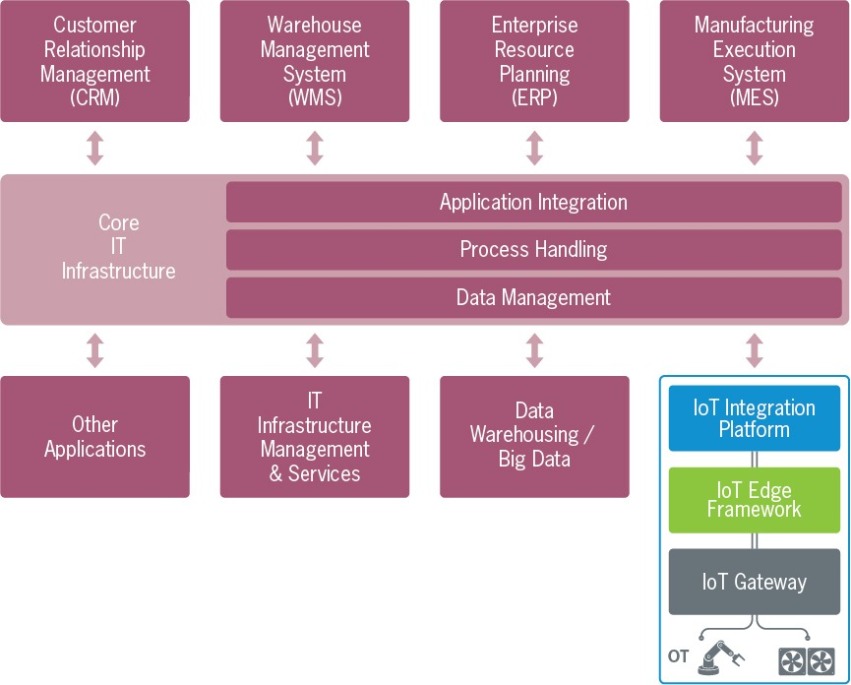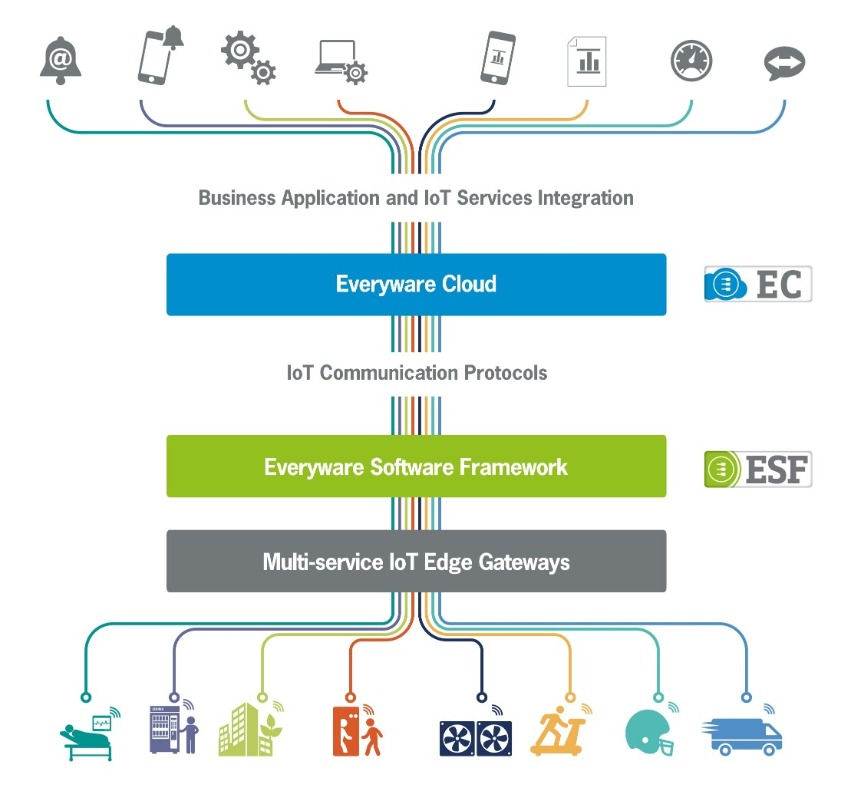- Home
- related story
- Quels sont les avantages de l'intégration de l’OT et de l’IT?
10 Mai 2019
Quels sont les avantages de l'intégration de l’OT et de l’IT?
The Internet of Things (IoT) and the digital transformation have brought the need for the companies - across all sector including Industrial, Transportation, Energy and Utilities and Medical - to collect actionable data from their assets, processes, and products. This requires the connection between the OT (Operational Technology) domain, that involves industrial and factory automation, supply chain management and asset monitoring - where data are generated - and the IT (Information Technology) domain, that embraces business process and office automation, enterprise web and mobile applications, etc. - where data are consumed.
Enabling integration between OT and IT domains is a mandatory requirement. Seamless connectivity is realized by an edge framework (that works as middleware at the edge of an IoT network) and an integration platform, normally located in the cloud or on premise in a data center. This combination is used to separate data generation from data usage.
How to integrate OT and IT
Devices in the OT domain communicate with one or more intelligent IoT gateways, using their own bearers and protocols (e.g. industrial protocols) and in turn transmit data to an integration platform, where data are processed into real-time information used by IoT services. This information is subsequently transmitted to mainstream enterprise services and it can be integrated with the historic information that they generate.
The IoT middleware applications enable end-to-end solutions that can be deployed in a virtual environment: in the same way, physical data sources and data consumer are connected through virtual communication links that abstract the complexity of physical communications (e.g. industrial protocols).
The real benefits of OT and IT Integration
The OT can benefit from this integration with a more efficient, scalable, managed and secured infrastructure onto which numerous applications are layered: they include predictive maintenance as well as remote asset monitoring and management. Benefits on the IT side include secure real-time communication with the enterprise’s assets while retaining the requisite efficiency for creating, scaling, maintaining and securing the infrastructure.
The result is increased operational performance, protection of profit margins, customer retention and the creation of new business models. Open, well-defined IoT architectures and their specific properties are the business transformation key. They unlock the potential of IoT ecosystems and transform any business into a smart business.
The IT infrastructure of an industrial manufacturing company typically embraces and interacts with the applications, processes and services showed in the picture below. An IoT Integration Platform – like Eurotech Everyware Cloud – allows the integration with the “world” of OT and allows secure communication with IoT assets in the field.

While the concept of iPaaS (integration Platform as a Service) typically entails the connection between applications within the IT domain, Everyware Cloud functions as a bridge between the field devices of the OT domain with the enterprise applications in the IT domain. Moreover, it does it by meeting the requirements of the OT domain and the needs of the enterprise IT infrastructure – allowing secure and remote device application management and enabling the IT applications to interact with these elements.
This integration facilitates the business digital transformation by connecting the data generated by OT devices that can be sent to the IT applications and the enterprise analytics located in the IT domain or data center that can have real-time access to those valuable data. To enable seamless integration between OT and IT, an IoT architecture should therefore enable access to data from devices across applications and build relationships between data sources in order to take different actions based on data coming from different areas.
Integrating OT and IT with Everyware IoT: the role of the IoT Integration Platform
The following schematic shows how Eurotech Everyware IoT edge-to-cloud architecture connects the devices in the field with Multi-service IoT Edge Gateways that communicate with the IoT Integration Platform to enable data exchange between OT with IT. By connecting data producers (sensors and actuators) with data consumers (business applications), the integration platform enables any-to-any communications, i.e. OT devices can communicate with all the applications at the IT level and the other way around in real-time.

Enabling the seamless flow of information between the Operational Technology and Information Technology domains represents a complex set of tasks. The Everyware Cloud (EC) IoT Integration Platform encapsulates this complexity to accommodate numerous vertical applications that are able to work together and communicate with each other. This enables functionalities to meet the needs of the new digital, data-driven economy and a cost-effective and efficient way to shorten time-to-market deployments.
Integrated OT and IT enterprise environments combine efficient operations with scalability and agility. For example, intelligent gateways located at the edge allow data analysis to be performed in a local facility, thereby generating real-time, insightful business intelligence that allows decisions to be made “in the moment”. And when applied to manufacturing operations, this information enables the creation of predictive maintenance programs that detect potential performance issues and allow them to be addressed before they occur.
Real-time decision-making is critical to business success. IoT architectures supply both the raw device data and sophisticated real-time local analytics that shape and guide intelligent business decisions. Without the requisite architecture and state-of-the-art analytics, and the right practices to take advantage of this development, companies will be stuck with the basic applications: monitoring, reporting, and simple rules-based operations. In other words, they will not be able to transition to the data-driven economy and at a later stage take part in the up-coming outcome economy.